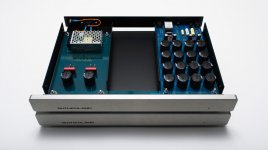Ok well I suppose we’re back to that disconnect again......if your math doesn’t add up in my reality then your always wrong and I’m always right?
Yes, you are always right... from your POW.
My truth could be a little more generally applicable than yours, but that should not be your concern. You can still stay happy as a clam at high tide with your own, private truth.
Last edited:
Could be. IIRC, as you mention now and then for circuits, its all been done before.
For a humor break. Wilhelm scream - Wikipedia
You did?
I didn't say that.
Look, in the bigger picture, high end audio design involves measurement and listening. The idea is to optimize both, if you can.
I didn’t say you did say that, it’s just a go to around here......you know it’s the squishy parts n’all
You wouldn’t think it involved listening at all from some posts.
For a humor break. Wilhelm scream - Wikipedia
I like the fact that the voice behind the scream was also the voice behind 'purple people eater' 🙂
Yes, you are always right... from your POW.
My truth could be a little more generally applicable than yours, but that should not be your concern. You can still stay happy as a clam at high tide with your own, private truth.
You just always seem to have the need to be right......I understand your response.
Oh break in is settling? I don't get that from your description of settling?
It wasn’t.....mark brought up break in.
I was talking disturbing the system in any way required settling.
Right, seems to me a different thing, you mentioned the system settling after a change of speaker cable for example. That wouldn't be a break in issue. I don't know why he used the term.
It happens a lot here 🙂 Break in is a one off, usually applied to speakers, settling is something else in my mind, a return to how it was before the change, is that what you meant?
ScottJ,
I agree that break in does apply to speakers with paper or other less initially-compliant surrounds.
However, as used in audio forums the term seems to be used more or less synonymously with settiling, i.e. stabilization and improvement of the sound sound of audio equipment after changes are made, often described as progressing to completion over a period of a few days to a few weeks.
I agree that break in does apply to speakers with paper or other less initially-compliant surrounds.
However, as used in audio forums the term seems to be used more or less synonymously with settiling, i.e. stabilization and improvement of the sound sound of audio equipment after changes are made, often described as progressing to completion over a period of a few days to a few weeks.
You just always seem to have the need to be right...
Your ears too

I like the fact that the voice behind the scream was also the voice behind 'purple people eater' 🙂
The film industry is so full of self references, homage references, inside jokes that sometimes I find myself scanning every wall or thing stuck on a refrigerator in every scene to find a new one.
ScottJ,
I agree that break in does apply to speakers with paper or other less initially-compliant surrounds.
However, as used in audio forums the term seems to be used more or less synonymously with settiling, i.e. stabilization and improvement of the sound sound of audio equipment after changes are made, often described as progressing to completion over a period of a few days to a few weeks.
Ok, but Bob mentioned settling after changing speaker cable, and a shorter time period, so I think he meant something else.
a return to how it was before the change, is that what you meant?
Well yes and no,
I always leave a change in the system for days even weeks evaluating.
It didn’t take long after I really got into fine tuning that I noticed the first hour or so of my test music wasn’t right. Then the changes would either come around, worse, better, or indifferent. I really noticed it the day I accidentally bought the wrong wire ,not noticing until after I removed the wire dujour, put back the same wire.....still noticed this ‘settling’.
I suppose there’s no need to even bring up bypass caps with regards to leading edge transients! 😱
Last edited:
Your ears too
There are plenty of people that see much better than I do......I’ve come to terms with it.
Ok, but Bob mentioned settling after changing speaker cable, and a shorter time period, so I think he meant something else.
Yes it’s strange but near as I can tell it upsets it’s ‘state’ .......nobody else has ever noticed this?
Most speaker wire needs break-in and so do quality line cords!
Not to look like a total moron, but hey why not.....
What about just taking off the speaker wires that were in use then re installing the same wires within a few minutes?
There was still a ‘settling’ period after turning it back on........is there a optimum ‘state’ that gets disturbed by such an action?
Last edited:
The Sutherland MCX phonostage ($6000) uses an AC-to-DC SMPS, see picture below. I wonder what happens when you use a quality line cord to connect it to the AC mains; ... do you suppose the line cord needs to be broken in?
I wonder the same thing about top quality Class-D amps like the Benchmark AHB-1 and AHB-2.
_
I wonder the same thing about top quality Class-D amps like the Benchmark AHB-1 and AHB-2.
_
Attachments
- Status
- Not open for further replies.
- Home
- Member Areas
- The Lounge
- John Curl's Blowtorch preamplifier part III
